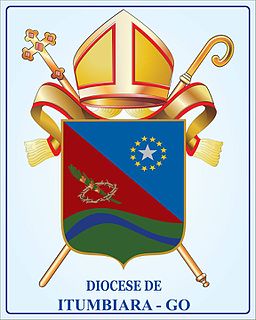
Celosia argentea, commonly known as the plumed cockscomb or silver cock's comb, is a herbaceous plant of tropical origin, and is known for its very bright colors. In India and China it is known as a troublesome weed.

Itumbiara is a municipality in the extreme south of the state of Goiás, Brazil. Its population in 2020 was of 105,809 in a total area of 2,461,3 km2 (2020). Itumbiara is one of the most prosperous cities in Goiás and is a major producer of soybeans, corn, cattle, and milk.

Cachoeira Dourada is municipality in south-central Goiás state, Brazil. The population was 8,031 (2020) in a total area of 521.1 km2.

Panamá is a municipality in south Goiás state, Brazil.
Banksia plumosa is a species of shrub that is endemic to Western Australia. It has hairy stems, broadly linear pinnatifid to pinnatipartite leaves with triangular lobes, creamy-yellow flowers in heads of up to eighty, and egg-shaped follicles.

Alex George's taxonomic arrangement of Dryandra was the first modern-day arrangement of that taxon. First published in Nuytsia in 1996, it superseded the arrangement of George Bentham, which had stood for over a hundred years; it would later form the basis for George's 1999 treatment of Dryandra for the Flora of Australia. In accordance with contemporary thinking, George treated Dryandra as a genus, dividing it into three subgenera, the largest of which was divided into 24 series. The arrangement stood until 2007, when Dryandra was transferred into Banksia as B. ser. Dryandra. No alternative has yet been proposed.

Libocedrus plumosa, with the common name kawaka, is a species of Libocedrus that is endemic to New Zealand.

Itumbiara Esporte Clube, usually known simply as Itumbiara, is a Brazilian football club from Itumbiara, Goiás state. The club competed in the Campeonato Brasileiro Série A in 1979 and won the state championship in 2008.

Araporã is a Brazilian municipality located in the west of the state of Minas Gerais. Its population as of 2020 was 6,931 people living in a total area of 298 square kilometres (115 sq mi). The city belongs to the statistical mesoregion of Triângulo Mineiro and Alto Paranaíba and to the microregion of Uberlândia. It became a municipality in 1992.

Verticordia plumosa, commonly known as plumed featherflower, is a flowering plant in the myrtle family, Myrtaceae and is endemic to the south-west of Western Australia. It was the first species in the genus to be described, although initially given the name Chamelaucium plumosum. It is a shrub with linear leaves and rounded groups of scented pink, mauve or white flowers. Two varieties of this species have been declared as being "threatened".

The Roman Catholic Diocese of Itumbiara is a diocese located in the city of Itumbiara in the Ecclesiastical province of Goiânia in Brazil.

Centralina is a Brazilian municipality located in the west of the state of Minas Gerais. Its population as of 2020 was 10,346 living in a total area of 322 km². The city belongs to the statistical mesoregion of Triângulo Mineiro and Alto Paranaíba and to the statistical microregion of Uberlândia. It became a municipality in 1954.

Monte Alegre de Minas is a Brazilian municipality located in the west of the state of Minas Gerais. Its population as of 2020 was 21,236 living in a total area of 2,593 km2 (1,001 sq mi). The city belongs to the statistical mesoregion of Triângulo Mineiro and Alto Paranaíba and to the statistical microregion of Uberlândia. It became a municipality in 1870.
Banksia plumosa subsp. plumosa is a subspecies of Banksia plumosa. As an autonym, it is defined as encompassing the type material of the species. It was known as Dryandra plumosa subsp. plumosa until 2007, when Austin Mast and Kevin Thiele sunk all Dryandra into Banksia. As with other members of Banksia ser. Dryandra, it is endemic to the South West Botanical Province of Western Australia.

Dryandra subg. Dryandra is an obsolete clade of plant. It was a series within the former genus Dryandra. The name was first published at sectional rank as Dryandra verae in 1830, before being renamed Eudryandra in 1847, the replaced by the autonym at subgenus rank in 1996. It was ultimately discarded in 2007 when Austin Mast and Kevin Thiele sunk Dryandra into Banksia.
Dryandra ser. Plumosae is an obsolete series within the former genus Dryandra. It was published by Alex George in 1996, but discarded in 2007 when Austin Mast and Kevin Thiele sank Dryandra into Banksia.
The football (soccer) Campeonato Brasileiro Série C 1998, the third level of Brazilian National League, was played from August 8 to December 6, 1998. The competition had 66 clubs and two of them were promoted to Série B.
Itumbiara is a genus of longhorn beetles of the subfamily Lamiinae, containing the following species:
Acropora plumosa is a species of acroporid coral that was first described by Dr. C. C. Wallace and J. Wolstenholme in 1998. Found in marine, tropical, reefs on slopes sheltered from wave action, and on reef walls. It occurs at depths between 10 and 30 m. It is classed as a vulnerable species on the IUCN Red List, and it has a decreasing population. It is not common and found over a large area and is classified under CITES Appendix II.

Petrophile plumosa is a species of flowering plant in the family Proteaceae and is endemic to southwestern Western Australia. It is a shrub with rigid, sharply-pointed, sometimes lobed leaves, and more or less spherical heads of hairy, pale yellow flowers.













